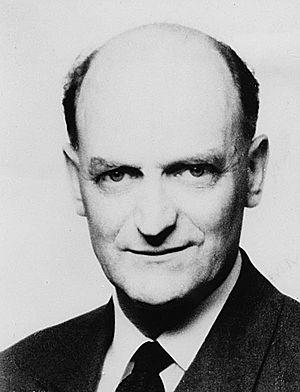William Phillips (economist) facts for kids
Quick facts for kids
William Phillips
|
|
|---|---|
 |
|
| Born |
Alban William Housego Phillips
18 November 1914 Te Rehunga near Dannevirke
|
| Died | 4 March 1975 (aged 60) |
| Nationality | New Zealand |
| Institution | London School of Economics Australian National University University of Auckland |
| Field | Macroeconomics |
| School or tradition |
Neo-Keynesian economics |
| Alma mater | London School of Economics |
| Influences | Irving Fisher John Maynard Keynes |
| Contributions | Phillips curve |
Alban William Housego "Bill" Phillips (born November 18, 1914 – died March 4, 1975) was an important economist from New Zealand. He spent most of his working life teaching economics at the London School of Economics (LSE) in England.
Phillips is most famous for something called the Phillips curve. He first wrote about this idea in 1958. He also created a special machine called the MONIAC in 1949. This machine was a hydraulic computer that helped show how an economy works.
Contents
Early Life and Adventures
Phillips was born in a place called Te Rehunga near Dannevirke, New Zealand. His father, Harold Housego Phillips, was a dairy farmer. His mother, Edith Webber, was a teacher and postmistress.
Before finishing school, Phillips left New Zealand. He went to Australia and worked many different jobs. These jobs included being a crocodile hunter and managing a movie theater.
In 1937, Phillips decided to travel to China. However, he had to quickly leave for Russia when Japan invaded China. He traveled across Russia on the Trans-Siberian Railway. In 1938, he finally made it to the United Kingdom. There, he began to study electrical engineering.
World War II Experiences
When World War II started, Phillips joined the Royal Air Force. He was sent to Singapore. When Singapore was taken over, he managed to escape on a ship called the Empire State. The ship was attacked but safely reached Java.
When Java was also captured, Phillips became a prisoner of war of the Japanese. He spent three and a half years in a prison camp. This camp was in what is now Indonesia. During his time there, he learned Mandarin Chinese from other prisoners. He also secretly fixed and made a radio smaller. He even built a secret water boiler for tea. He connected it to the camp's lighting system.
In 1946, he was honored for his service in the war. He was made a Member of the Order of the British Empire (MBE).
From War to Economics
After the war, Phillips moved to London. He started studying sociology at the London School of Economics. He was very interested in how prisoners of war organized themselves. But he soon found sociology boring. He became very interested in Keynesian theory.
So, he changed his studies to economics. In just eleven years, he became a professor of economics at the LSE.
His Work in Economics
While he was a student at the LSE, Phillips used his engineering skills. He created the MONIAC. This was a special analogue computer. It used water and pipes to show how the British economy worked. People liked it a lot. Phillips was soon offered a teaching job at the LSE. He quickly moved up and became a professor in 1958.
The Phillips Curve
Phillips studied information about the British economy. He noticed something interesting. In years when many people were out of work (high unemployment rate), wages usually stayed the same or even went down. But when few people were out of work (low unemployment), wages went up quickly.
Other economists, like Irving Fisher, had noticed similar patterns. But in 1958, Phillips published his own important work. It showed the connection between rising prices (inflation) and unemployment. This connection was shown using a graph called the Phillips curve.
After Phillips' paper came out, many economists and leaders became interested. They thought it meant there was a choice: either a strong economy with low unemployment or low inflation. Paul Samuelson and Robert Solow wrote a famous article about the Phillips curve in the United States.
The idea of the Phillips curve has changed over time. But it is still a very important part of how economists study big economic changes. Some people believe Phillips might have won a Nobel Prize if he had lived longer. He also made other important contributions to economics. These were especially about how to keep an economy stable.
Later Life and Retirement
In 1967, Phillips moved back to Australia. He took a job at Australian National University. This job allowed him to spend half his time studying Chinese.
In 1969, his health declined, and he had a stroke. This made him retire early. He then returned to Auckland, New Zealand. He taught at the University of Auckland for a short time. He passed away in Auckland on March 4, 1975.
See also
 In Spanish: William Phillips (economista) para niños
In Spanish: William Phillips (economista) para niños


